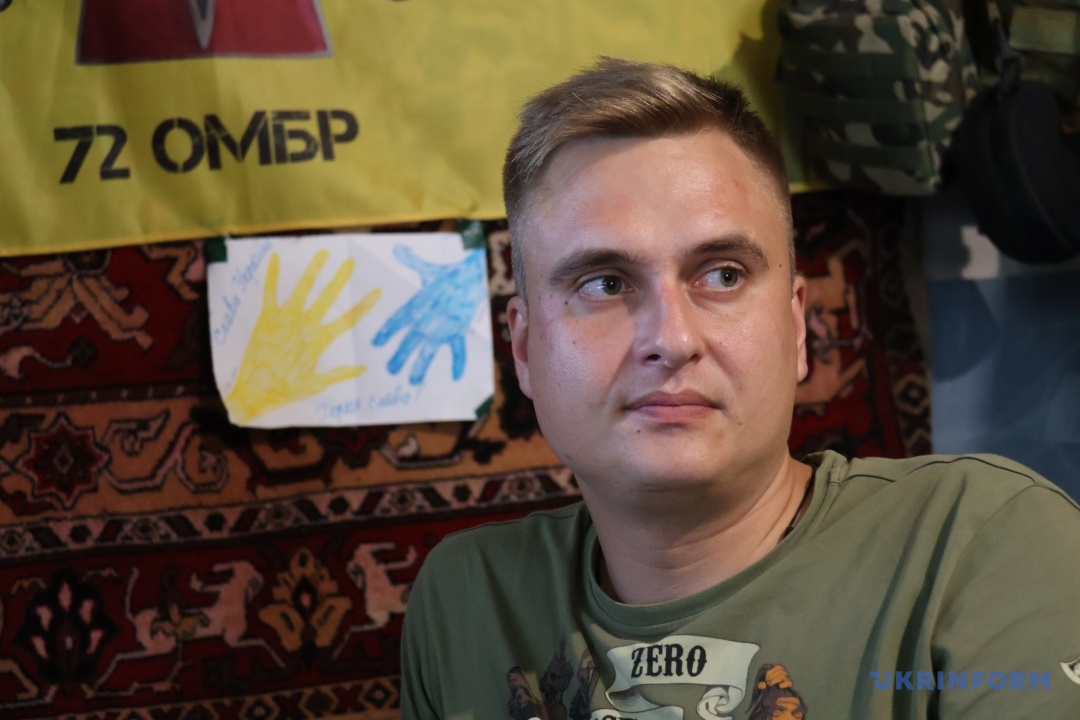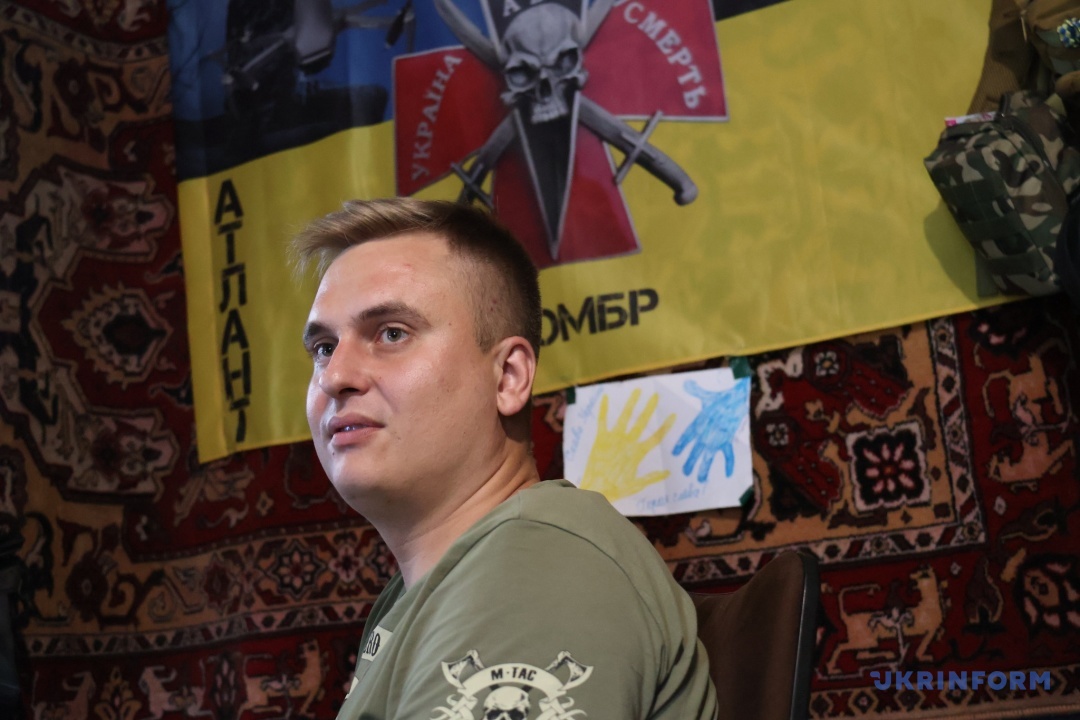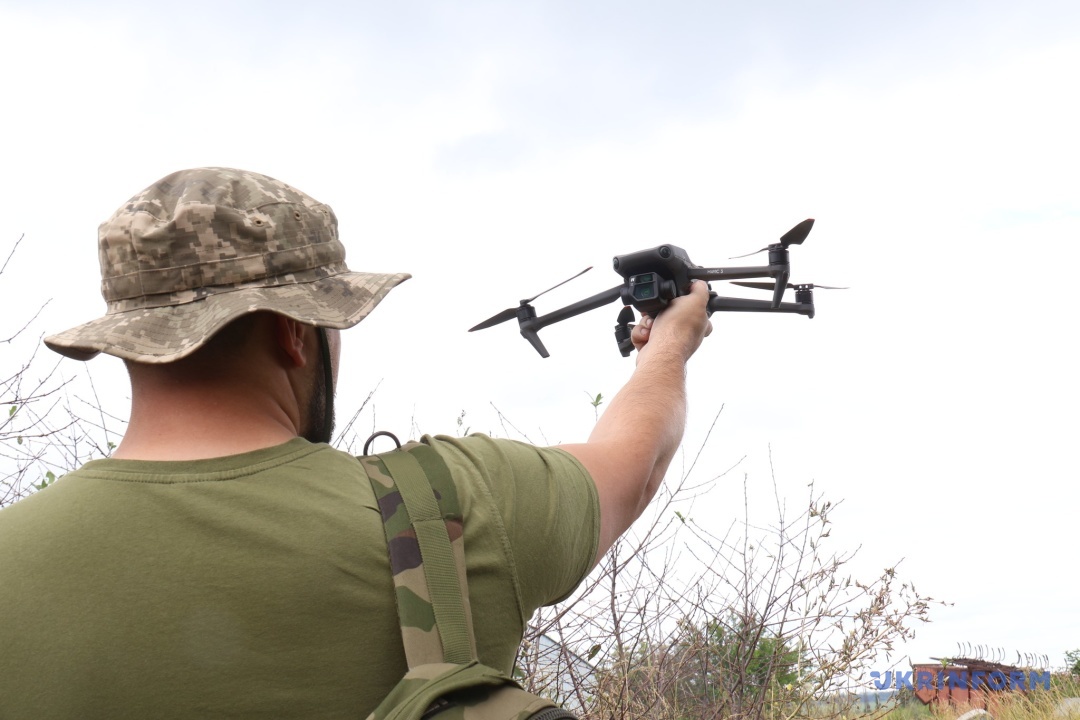The 72nd Brigade of the Armed Forces of Ukraine is special to everyone who lives in Kyiv. No matter which way from the capital we go (Irpin, Demydiv, Brovary), the story of last winter awaits you everywhere, how these guys defended the capital against all predictions, all military theories, against all odds.
Today they are fighting in Donbas. The units of the brigade that once saved Kyiv are stationed in the Donetsk region. We enter a house in the town where a drone company is stationed. Here, nine monitors show a color picture: Ukrainian drones "dots" hovering in the air, and you can see how beautiful the Ukrainian steppe is. Behind the monitor sits the head of the UAV strike company, who is recognized from many interviews and goes by the call sign "Student."
If at the beginning of the war it was said that this war would be a war of artillery, now they say that it has turned into a war of UAVs. If last year we asked experts whether a drone would reach Moscow, today we applaud when they regularly reach there.
In fact, we are talking to our interlocutor about how UAVs have changed the war.
Our conversation is interrupted by short commands. It is often the slang of the "pilots" and I listen to these "dialogues of war".
- "Penguin, fly out," says the Student.
- There is a joke that penguins are swallows that ate at night, gained weight and stopped flying, I say.
- Our Penguin flies, says the Student, he is athletic. In general, it goes like this: we look for a target, immediately send our 'birds' there. And our pilots hit the target with certain types of ammunition.
- Tell me, do the Russians see our territory the same way we see the territory they control?
- At least they are trying to. That's why we don't show our monitors or tell them how they work - they quickly process this information.
- When you were defending Kyiv, did you have drones yet? And how do you remember the time after the defense of Kyiv?
- UAVs were not used there on a large scale. Before Bayraktars, the topic was underdeveloped. After the liberation of Kyiv region, we still worked in the artillery. There were raids, we moved out to catch up with the enemy. One battalion went towards Chornobyl, the other towards Sumy. From Sumy, we went to the Kharkiv direction. In that raid, together with the Territorial Defense Forces (TRO), we reached the border with artillery.

From the Kharkiv direction, we were transferred to Lysychansk, then to Komyshuvakha, and we fought there as well. At that time, there were still enough shells for Grad: we fired more than 1,000 shells in twelve days, and the intensity of the battle was very high. And we realized that artillery is blind without aerial reconnaissance, so we started to take an active interest in it. The first function of the UAV was reconnaissance. And then we realized how effective the drone is when it comes to destroying a target. In artillery, there are a lot of targets, and some of them are quite fast, they can run away... So it would be more efficient to destroy something from a drone at once. We were not the only ones who realized this. At the beginning of '23, by order of Commander-in-Chief Zaluzhnyi, companies of attack UAVs began to be created. In January, we found out that a strike group was being formed in our unit as well. I was offered to lead it. We train every day. January of this year was the most active in the development of strike reconnaissance. We started using systems for dropping ammo on reconnaissance Mavics.
The Student is distracted, giving orders again to Penguin, Coyote, and Cradle. On the monitors, dots are "walking" over the bright Ukrainian steppe.
- "What's happening now?" I point to the screen.
- Evacuation of wounded Russians, now they will be taken away. We've already dropped something, and now they're scattering to their homes. Very often it happens that we wound one of them, an evacuation team comes to get him, we wound someone else, and another team comes. The maximum result of such an action is four 200s [dead] and nine 300s [wounded]. You can see that we are now clearing their dugouts with mines.

- Do you have a technical education?
- Yes, I studied at a polytechnic college. But here, we were just researching how intelligence is developing in the brigade, flying a little ourselves, taking various courses, online, gaining experience. Normal courses take a month and a half. There are training centers.
- There is talk of alleged resource overruns when drones, the same Mavic, are used as an attack drone.
- Artillery often uses dozens of shells to destroy a single target. With Mavic, we are able to precisely and accurately "open" dugouts, "200s" and "300s" of the enemy, destroying their equipment. That is why it is very unpleasant to hear such talk. You say we are wasting copters? The price of one Mavic is equal to the price of one 155-caliber shell. If you convert the price of a copter into the equivalent of shells, it will be a penny. For example, in June (we had a few Kamikazes and mostly Mavics), we have the following result: twenty-two 200s, fifty-two 300s, and five armored vehicles destroyed. And we spent two dozen Mavics on all of this in one month. We spent 25-30,000 dollars, and this is nothing compared to the amount of enemy and equipment we destroyed, where one unit of destroyed equipment completely covers all our expenses.
- Some volunteers say: don't be sorry, the price of one Mavic in reconnaissance is the price of the life of one of our soldiers who will not have to go behind enemy lines.
- We, as military men, do the math. We take care of every Mavic, we even have our own mini-workshop for their repair. They fall, they get shot down, and we find everything we can to repair and reassemble them.
And in the second half of June, we received the first 15 FPV kamikazes.
- To learn to fly like this, what do you need first of all?
- The desire. We have uncles who are over 40 years old and fly better than guys in their twenties. They have an understanding of it all: what, why, how and where. But in general, everyone wants to contribute to the Victory. Our youngest fighter is nineteen years old, the oldest is fifty-five.
We first require everyone to learn how to conduct reconnaissance, so that people understand how it all looks from above, and only then do we transfer them to the dumps [dumping of the ammo]. We tried to put some pilots on the dumps right away and realized that they lacked practice. It's just like piloting an airplane: first, a long flight, and only then do you start doing dumps, you need to use your head to avoid losing the drone, you need experience, knowledge of tactics, trick...
- How does the drone-artillery duo work?
- Harmoniously, we are constantly in touch with the artillery. They start their work, we fly up to add and correct. Between volleys, we can add something to certain points - in trenches, in dugouts. At first, the UAV's strike companies were more of a joke. It was still a training exercise, something didn't work out, copters were lost. Today, everyone realizes the value of the strike company and the amount of work we do. Very often the artillery asks us: can you destroy this or that?
- Tell me, when did you ever have a sense of triumph in the war?
- When the enemy equipment was destroyed by the first kamikaze hits. At first, it was difficult: the antenna didn't work, it was jammed, or something else. The first successes were like a triumph. Nowadays, if you haven't killed an enemy or destroyed some equipment, you feel like you've wasted a day. And when you killed a few, dozen of 300s, and burned some more equipment, then your mood is normal.
- Is there a connection between work efficiency and the height to which the drone flies?
- It depends on what you want to do. If you want to conduct reconnaissance, then, of course, you can go higher. But to make adjustments, you need to fly as close to the target as possible; the longer the range, the less effective it is, because the pilot has to determine whether to overfly, underfly, left or right, and how many meters. And for strike missions, we go as low as possible. That's why, a priori, our UAV consumption is higher than that of reconnaissance. We take risks.
In January, there were several cases when artillery was firing but could not hit. And then one Mavic takes off with a single shell and throws it, injures one - they immediately realize everything, grab the wounded man under the bark and run back. The Russians are still moving under shelling. But when they are hit by copters, the accuracy is much higher. And then one ammo was dropped - and that was it, the whole assault was over for the enemy.
- What is the contribution of drones to the fact that the Armed Forces of Ukraine have been holding Vuhledar for so long?
- In January 23, the assault on Vuhledar began, and we were attacked by three or four brigades, but we repelled them with dignity. In the biggest assault, they used 120 armored vehicles at once. Those were difficult days. But we also destroyed 150 units of enemy equipment...
We showed how capable we are today. That's why we have been without rotation in the Donetsk sector for more than a year. And if you take those who went from Kyiv to Sumy, the guys have never been on rotation at all, they just had short vacations.
Now it's much more interesting to work, you see the enemy, you see how you destroy him. It's not like someone told you: they shot there, and then - probably two 200s. Each of our figures is a 100% confirmed result.
- Do we have more drones now or do the Russians?
- Probably, they have more drones by number, but we use them better. Moreover, their electronic warfare is many times better than ours.
- Is it better to have ready-made Western models or our own?
- We need to develop our own. By the way, we are developing it rapidly, but we just need to invest in something that already shows results. And if it doesn't, we need to tell the developers: guys, prove it, bring it, test it not somewhere in Dnipro, Kyiv, or Lviv. If you show us how it flies here, come here, where the EW works. Sometimes a manufacturer will bring six airplanes, and four of them cannot take off because they were shaken during transportation. But in general, our designs can compete quite well.
Our kamikazes, which cost 500-600 dollars, perform the same tasks as imported ones.
It is very important for the company to be constantly supplied, because if there is a shortage of Mavic or other supplies, we will not be able to help the infantry in some places, or a pilot will lose his skills because he will be doing something stupid for a week. Or when you have only two kamikazes, and you look at the target and think: no, I'm not going to fly at this one, because it's a pity, because I have only two... Yesterday, for example, a mortar was destroyed on the second run, because the first one missed by a meter, they did additional reconnaissance, launched the second one - a direct hit in the barrel(!). Two kamikazes cost, roughly speaking, $1100, and a destroyed mortar costs tens of thousands of dollars.... And this mortar caused very heavy losses to the infantry...
- How would you classify unmanned aerial vehicles?
- Reconnaissance, bombers, night bombers, kamikazes (those that fly in one direction), wings (UAVs built on the "airplane" aerodynamic principle). Wings mean a range of at least thirty kilometers. Wings are the future, the enemy is already using kamikaze wings, you've heard of Lancets. Each direction should have all types of weapons. For example, if it's a trench, it's better to throw a grenade with a copter. If it's a car or a mortar, then nothing will be better than a kamikaze. FPV kamikazes cover a distance of ten kilometers, and then the "wings" come in. Each target should have its own UAV. By the way, we already have domestic wings, they are in our brigade at the stage of contracting.

- What's better, one Wing or several Mavic?
- No, of course, a wing is very good, because it is a distance. This is an opportunity to cover the nearest settlements. The enemy is very afraid to move there, because FPV, or the same Mavic with a "tricky" modification, flies 12-15 kilometers and can carry a minimal charge. And if we had a wing, it would give us another fifteen kilometers, we could push the enemy's equipment even further, 30 kilometers. This would, first of all, give us time to react to the movement of their equipment, which we could cut off, knock out their artillery, which is punishing cities, the same Vuhledar..
The Student looks at the screen and says: "Played too much..." Then he explains.
- "Our fighter decided to throw a grenade and lost his drone: he was going down and down and lost his copter. It's just a moment when you want to go as low as possible to hit the target. And you have to feel this edge, when you can still descend, but very carefully, and then you drop it and come back up.
- All domestic drones were initially made on the knees somewhere, in garages? Am I understanding this correctly?
- It varies, but, in principle, it all starts with that. The first Ukrainian "wings" of the Poseidon were used at the end of March 22nd to defend Kyiv.
In every city, you can find manufacturers, roughly speaking, in the basement, but in general, some of them can do things that are out of this world. For example, we are very pleased with the FPV drones we are currently using. But the "wing" is the future.
- How do you keep our assault teams alive?
- We cover them. That is, we see them going into a dugout, for example, where someone is shooting - we fly up there, throw a grenade, and the infantry finishes them off. Sometimes the group is still on the way, and we hit them accurately, and the enemy infantry is already retreating.
- When we win this war, will it be possible to say that it was won by a Ukrainian UAV, i.e. yours?
- No, it won't. Today we are more popular, but tomorrow there will be some superHIMARS or something else. We can show a cool picture of the enemy being destroyed. Today, we are probably one of the most effective units in every brigade, if everything is organized properly. But we cannot negate the work of the artillery, those who repel the enemy, who storm, who drive heavy equipment, who provide cover.
In general, shock companies are constantly working with explosives, grenades, it is all dangerous. The ammunition has to be prepared for dropping. And a grenade, for example, has different fuses, and some of them don't work well.... Well, we didn't have any losses because of this, but it happened in neighboring units.
Ukraine is now ahead of all other countries in this area. Once upon a time, people in the US used to say that a copter could fly through a window and kill someone. And for us, it's now a kind of routine...
Lana Samokhvalova, Kyiv - Donetsk region - Kyiv
Photo by Pavlo Bagmut
